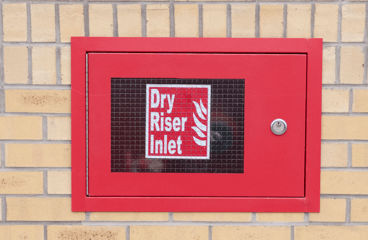A very Dry Riser
I am lucky to get to talk with so many amazing people from all walks of life on a daily basis. Some of the conversations are so deeply technical that I need help from Google after the event to translate. Some are deeply philosophical and others start out as a standard chat but unexpectedly take a turn that, if I’m not careful, can quickly turn to despair. In this case, it started with a comment from a resident about an ‘out of the blue’ £25,000 bill for repairs to their dry riser.

DRY RISER: A large water pipe the Fire Service connect their truck to outside the building to pump water up to each floor.
A recent change of managing agent had prompted a pressure test of the dry riser and it had failed. On further inspection, it was found that pipework was missing and would need to be installed (hence the £25k bill).
The dry riser in this building would never have worked!
So for over 6 years the residents in this building have relied on a critical piece of fire fighting kit that is in fact useless. Firefighters arriving at the building would have wasted precious time trying to work out why the dry riser was failing. Fire Risk Assessors would have wrongly factored the dry riser into their reviews. Insurers would have assumed the presence of a dry riser into their pricing.
This FAILURE could have cost the lives of residents and firefighters!
In the context of Grenfell and the wider Building Safety Crisis, we should not be surprised about this failure but we should be shocked and ask ourselves…
“How could this happen?”
In theory, this type of failure should not be possible, but we see evidence of these simple failures on a daily basis. Let’s look at what should have happened with the dry riser.
Installation of the Dry Riser
The contractor that originally installed the dry riser should have issued an Installation Certificate to comply with BS9990. This certificate should have been handed over to the Responsible Person (building manager) on practical completion.
Ongoing inspection and maintenance
The Responsible Person should have arranged for the dry riser to have been maintained to comply with BS9990. This requires a visual inspection every 6 months and a pressure test every 12 months. Each of these tests would be shown in an engineer’s report.
So, by the 6 year point the building manager should have an installation certificate plus 12 inspection reports. 7 of these reports would have been pressure tests. Each one would have been a FAILURE and would have prompted an urgent fix.
We don’t know the full details of this case (yet) and thankfully the building didn’t burn down over this 6 year period. A regulatory review has not taken place, however, this is what I think may have happened:
- Dry Riser installer made mistakes and didn’t commission it to comply with BS9990
- Developer didn’t hand over documents to comply with Regulation 38 of the Building Regulations (common problem)
- Regulation 38 information was not properly checked by the Responsible Person
- The Responsible Person didn’t have a process or the competence to identify critical fire safety systems and appoint maintenance contractors
- The dry riser was not maintained and tested to comply with BS9990
- Issues were first identified when there was a change of Managing Agent and the new one did their job properly
- Multiple fire risk assessors assumed that critical fire safety systems were being maintained and tested. An example of wording from a recent fire risk assessment stated:
“No evidence was available to confirm regular inspection, testing and servicing of the Dry Riser”
How to keep buildings safe
The starting point is that residential apartment buildings are pretty simple things. They are not complex like nuclear power stations, chemical plants or submarines, Sadly, much of the overly complex new legislation would have you believe otherwise. We need to keep it simple.
3 steps to save lives (for residents and building managers)
- Identify the critical fire and life safety systems in your building
- Make sure they are all maintained and tested in accordance with the law and British Standards (ask to see the evidence)
- Adopt a zero tolerance approach to non-compliance (if it’s not evidenced it doesn’t exist)
1 step to save lives (for the government)
Create and fund effective regulatory oversight that is digital first and data led.
Building Safety Logbook
A huge step forward in Building Safety can be achieved by the immediate implementation of a Building Safety Logbook for all higher risk buildings. The solution is immediately available to deploy and the monthly cost per building is insignificant.
Each logbook should manage the evidence of essential fire and life safety information within the building. It should contain the Fire Risk Assessment, Evacuation Plan, Dry/Wet Riser, Emergency Lighting, Firefighting Lift, Smoke Vents, Fire Alarm, Fire Doors etc.
The digital logbook provides real time, secure and evidential oversight to building management, residents, fire service, insurers, regulators and other stakeholders. There is no reasonable excuse not to have one.
Here is a snapshot of how the Dry Riser section of the digital logbook should look:
With a Building Safety Logbook you can prove your building is safe now and kept safe for tomorrow.
